The Dominant Climate Change Event for Salinity Intrusion in the GBM Delta
Abstract
1. Introduction
2. Study Area
3. Methodology
3.1. Model Calibration and Validation
3.1.1. Visualization of Model Performance during Calibration and Validation
3.1.2. Quantification of Model Performance
3.2. Descriptions of Scenarios
3.2.1. Reduced Discharge
3.2.2. Sea Level Rise
3.2.3. Cyclonic Scenario
4. Result and Discussion
4.1. Base Salinity Condition from Measurement
4.2. Impact of Reduced Upstream Discharge on Salinity Intrusion
4.3. Impact of Sea Level Rise on Salinity Intrusion
4.4. Impact of Cyclone on Salinity Intrusion
4.5. Salinity Intrusion in Changing Climate
4.6. Salinity Intrusion in Extremely Severe Climatic Condition
5. Conclusions
Author Contributions
Limitations
Funding
Acknowledgments
Conflicts of Interest
References
- Dasgupta, S.; Huq, M.; Khan, Z.H.; Ahmed, M.M.Z.; Mukherjee, N.; Khan, M.F.; Pandey, K. Cyclones in a changing climate: The case of Bangladesh. Clim. Dev. 2014, 6, 96–110. [Google Scholar] [CrossRef]
- Nicholls, R.J.; Hutton, C.W.; Lázár, A.N.; Allan, A.; Adger, W.N.; Adams, H.; Wolf, J.; Rahman, M.; Salehin, M. Integrated assessment of social and environmental sustainability dynamics in the Ganges-Brahmaputra-Meghna delta, Bangladesh. Estuar. Coast. Shelf Sci. 2016, 183, 370–381. [Google Scholar] [CrossRef]
- Saito, Y. Deltas in Southeast and East Asia: Their evolution and current problems. In Proceedings of the APN/SURVAS/LOICZ Joint Conference on Coastal Impacts of Climate Change and Adaptation in the Asia–Pacific Region, APN, Kobe, Japan, 14–16 November 2000; pp. 185–191. [Google Scholar]
- De Souza, K.; Kituyi, E.; Harvey, B.; Leone, M.; Murali, K.S.; Ford, J.D. Vulnerability to climate change in three hot spots in Africa and Asia: Key issues for policy-relevant adaptation and resilience-building research. Reg. Environ. Chang. 2015, 15, 747–753. [Google Scholar] [CrossRef]
- Dearing, J.A.; Hossain, S. Recent Trends in Ecosystem Services in Coastal Bangladesh. Ecosyst. Serv. Well-Being Deltas 2018, 93–114. [Google Scholar] [CrossRef]
- Werner, A.D.; Bakker, M.; Post, V.E.; Vandenbohede, A.; Lu, C.; Ataie-Ashtiani, B.; Simmons, C.T.; Barry, D.A. Seawater intrusion processes, investigation and management: Recent advances and future challenges. Adv. Water Resour. 2013, 51, 3–26. [Google Scholar] [CrossRef]
- Wu, H.; Zhu, J.; Choi, B.H. Links between saltwater intrusion and subtidal circulation in the Changjiang Estuary: A model-guided study. Cont. Shelf Res. 2010, 30, 1891–1905. [Google Scholar] [CrossRef]
- Barlow, P.M.; Reichard, E.G. Saltwater intrusion in coastal regions of North America. Hydrogeol. J. 2010, 18, 247–260. [Google Scholar] [CrossRef]
- Neubauer, S.C. Ecosystem responses of a tidal freshwater marsh experiencing saltwater intrusion and altered hydrology. Estuaries Coasts 2013, 36, 491–507. [Google Scholar] [CrossRef]
- Yanosky, T.M.; Hupp, C.R.; Hackney, C.T. Chloride concentrations in growth rings of Taxodium distichum in a saltwater-intruded estuary. Ecol. Appl. 1995, 5, 785–792. [Google Scholar] [CrossRef]
- Craft, C.; Clough, J.; Ehman, J.; Joye, S.; Park, R.; Pennings, S.; Guo, H.; Machmuller, M. Forecasting the effects of accelerated sea-level rise on tidal marsh ecosystem services. Front. Ecol. Environ. 2009, 7, 73–78. [Google Scholar] [CrossRef]
- Werner, A.D.; Simmons, C.T. Impact of sea-level rise on sea water intrusion in coastal aquifers. Groundwater 2009, 47, 197–204. [Google Scholar] [CrossRef]
- Rosegrant, M.W.; Ringler, C.; McKinney, D.C.; Cai, X.; Keller, A.; Donoso, G. Integrated economic-hydrologic water modeling at the basin scale: The Maipo River basin. Agric. Econ. 2005, 24, 33–46. [Google Scholar] [CrossRef]
- Wang, B.; Zhu, J.; Wu, H.; Yu, F.; Song, X. Dynamics of saltwater intrusion in the Modaomen Waterway of the Pearl River Estuary. Sci. China Earth Sci. 2012, 55, 1901–1918. [Google Scholar] [CrossRef]
- Winn, K.O.; Saynor, M.J.; Eliot, M.J.; Elio, I. Saltwater intrusion and morphological change at the mouth of the East Alligator River, Northern Territory. J. Coast. Res. 2006, 137–149. [Google Scholar] [CrossRef]
- Antonellini, M.; Mollema, P.; Giambastiani, B.; Bishop, K.; Caruso, L.; Minchio, A.; Pellegrini, L.; Sabia, M.; Ulazzi, E.; Gabbianelli, G. Salt water intrusion in the coastal aquifer of the southern Po Plain, Italy. Hydrogeol. J. 2008, 16, 1541. [Google Scholar] [CrossRef]
- Zhang, E.; Savenije, H.H.; Wu, H.; Kong, Y.; Zhu, J. Analytical solution for salt intrusion in the Yangtze Estuary, China. Estuar. Coast. Shelf Sci. 2011, 91, 492–501. [Google Scholar] [CrossRef]
- Junot, J.A.; Poirrier, M.A.; Soniat, T.M. Effects of saltwater intrusion from the Inner Harbor Navigation Canal on the benthos of Lake Pontchartrain, Louisiana. Gulf Caribb. Res. 1983, 7, 247–254. [Google Scholar] [CrossRef]
- Qiu, C.; Zhu, J.R. Influence of seasonal runoff regulation by the Three Gorges Reservoir on saltwater intrusion in the Changjiang River Estuary. Cont. Shelf Res. 2013, 71, 16–26. [Google Scholar] [CrossRef]
- Han, Z.-C.; Cheng, H.-P.; Shi, Y.-B.; You, A.-J. Long-term predictions and countermeasures of saltwater intrusion in the Qiantang estuary. J. Hydraul. Eng. 2012, 2. [Google Scholar]
- Shaha, D.C.; Cho, Y.K.; Kim, T.W. Effects of river discharge and tide driven sea level variation on saltwater intrusion in Sumjin River estuary: An application of finite-volume coastal ocean model. J. Coast. Res. 2012, 29, 460–470. [Google Scholar] [CrossRef]
- Gong, W.; Shen, J. The response of salt intrusion to changes in river discharge and tidal mixing during the dry season in the Modaomen Estuary, China. Cont. Shelf Res. 2011, 31, 769–788. [Google Scholar] [CrossRef]
- Xu, H.; Lin, J.; Wang, D. Numerical study on salinity stratification in the Pamlico River Estuary. Estuar. Coast. Shelf Sci. 2008, 80, 74–84. [Google Scholar] [CrossRef]
- Feseker, T. Numerical studies on saltwater intrusion in a coastal aquifer in northwestern Germany. Hydrogeol. J. 2007, 15, 267–279. [Google Scholar] [CrossRef]
- Zhou, W.; Wang, D.; Luo, L. Investigation of saltwater intrusion and salinity stratification in winter of 2007/2008 in the Zhujiang River Estuary in China. Acta Oceanol. Sin. 2012, 31, 31–46. [Google Scholar] [CrossRef]
- Van Aken, H.M. Variability of the salinity in the western Wadden Sea on tidal to centennial time scales. J. Sea Res. 2008, 59, 121–132. [Google Scholar] [CrossRef]
- Sumaiya, H.A.; Rahman, M.; Elahi, W.E.; Ahmed, I.; Rimi, R.A.; Alam, S. Modelling Salinity Extremes in Bangladesh Coast. In Proceedings of the 5th International Conference on Water & Flood Management (ICWFM-2015), Dhaka, Bangladesh, 6–8 March 2015. [Google Scholar]
- Hussain, M.A.; Islam, A.; Hasan, M.A.; Bhaskaran, B. Changes of the seasonal salinity distribution at the Sundarbans coast due to impact of climate change. In Proceedings of the 4th International Conference on Water & Flood Management (ICWFM-2013), Dhaka, Bangladesh, 9–11 March 2013; pp. 637–648. [Google Scholar]
- Akter, R.; Sumaiya, S.; Rahman, M.; Ahmed, T.; Sakib, M.; Haque, A.; Rahman, M.M. Prediction of Salinity Intrusion due to Sea Level Rise and Reduced Upstream Flow in the GBM Delta. In Proceedings of the 20th Congress of the Asia Pacific Division of the International Association for Hydro Environment Engineering & Research (IAHR), Colombo, Sri Lanka, 28–31 August 2016. [Google Scholar]
- Bashar, K.E.; Hossain, M.A. Impact of sea level rise on salinity of coastal area of Bangladesh. In Proceedings of the 9th International River Symposium, Brisbane, Australia, 4–7 September 2006. [Google Scholar]
- Akhter, S.; Hasan, M.M.; Khan, Z.H. Impact of climate change on saltwater intrusion in the coastal area of Bangladesh. In Proceedings of the 8th International Conference on Coastal and Port Engineering in Developing Countries (COPEDEC 2012), Chennai, India, 20–24 February 2012. [Google Scholar]
- Bricheno, L.M.; Wolf, J.; Islam, S. Tidal intrusion within a mega delta: An unstructured grid modelling approach. Estuar. Coast. Shelf Sci. 2016, 182, 12–26. [Google Scholar] [CrossRef]
- Bhuiyan, M.J.A.N.; Dutta, D. Assessing impacts of sea level rise on river salinity in the Gorai river network, Bangladesh. Estuarine. Coast. Shelf Sci. 2012, 96, 219–227. [Google Scholar] [CrossRef]
- Mirza, M.M.Q. Effects on Water Salinity in Bangladesh. In The Ganges Water Diversion: Environmental Effects and Implications; Water Science and Technology Library; Springer: Dordrecht, The Netherlands, 2004; Volume 49, pp. 1–12. [Google Scholar] [CrossRef]
- Akter, R.; Sakib, M.; Rahman, M.; Sumaiya, S.; Haque, A.; Rahman, M.M.; Islam, R. Climatic and Cyclone Induced Storm Surge Impact on Salinity Intrusion along the Bangladesh Coast. In Proceedings of the 6th International Conference on the Application of Physical Modeling in Coastal and Port Engineering and Science (Coastlab 2016), Ottawa, ON, Canada, 11–13 May 2016; Available online: http://rdio.rdc.uottawa.ca/publications/coastlab16/coastlab6.pdf (accessed on 19 May 2019).
- WARPO. Coastal Development Strategy. In Ministry of Water Resources, Government of the People’s Republic of Bangladesh; Water Resources Planning Organization (WARPO): Dhaka, Bangladesh, 2006. [Google Scholar]
- Baten, M.A.; Seal, L.; Lisa, K.S. Salinity Intrusion in Interior Coast of Bangladesh: Challenges to Agriculture in South-Central Coastal Zone. Am. J. Clim. Chang. 2015, 4, 248–262. [Google Scholar] [CrossRef]
- Haque, A.; Sumaiya; Rahman, M. Flow Distribution and Sediment Transport Mechanism in the Estuarine Systems of Ganges-Brahmaputra-Meghna Delta. Int. J. Environ. Sci. Dev. 2016, 7, 22. [Google Scholar] [CrossRef]
- Munsur Rahman, A.H.; Siddique, M.K.; Rezaie, A.M.; Hafez, M.; Ahmed, R.J.; Darby, S.; Wolf, J.; Sarker, M.H.; Alam, S.; Ahmed, I.; et al. A preliminary assessment of the impact of fluvio-tidal regime on Ganges-Brahmaputra-Meghna delta and its impact on the ecosystem resources. In Proceedings of the International Conference on Climate Change Impact and Adaptation (I3CIA-2013), Gazipur, Bangladesh, 15–17 November 2013. [Google Scholar]
- Ali, A. Climate change impacts and adaptation assessment in Bangladesh. Clim. Res. 1999, 12, 109–116. [Google Scholar] [CrossRef]
- Sarker, M.H.; Akter, J.A.K.I.A.; Ferdous, M.R.; Noor, F.A.H.M.I.D.A. Sediment dispersal processes and management in coping with climate change in the Meghna Estuary, Bangladesh. In Proceedings of the Workshop on Sediment Problems and Sediment Management in Asian River Basins, Hyderabad, India, September 2009; IAHS: Hyderabad, India; pp. 203–218, Publication 349.
- Zaman, A.M.; Molla, M.K.; Pervin, I.A.; Rahman, S.M.; Haider, A.S.; Ludwig, F.; Franssen, W. Impacts on river systems under 2 °C warming: Bangladesh Case Study. Clim. Serv. 2017, 7, 96–114. [Google Scholar] [CrossRef]
- Komol, K.U. Numerical Simulation of Tidal Level at Selected Coastal Area of Bangladesh. Master’s Thesis, Bangladesh University of Engineering and Technology (BUET), Dhaka, Bangladesh, 2011. [Google Scholar]
- Brammer, H. Bangladesh’s dynamic coastal regions and sea-level rise. Clim. Risk Manag. 2014, 1, 51–62. [Google Scholar] [CrossRef]
- Flierl, G.R.; Robinson, A.R. Deadly surges in the Bay of Bengal: Dynamics and storm-tide tables. Nature 1972, 239, 213. [Google Scholar] [CrossRef]
- Pattullo, J. The seasonal oscillation in sea level. J. Mar. Res. 1955, 14, 25–39. [Google Scholar]
- Lesser, G.R.; Roelvink, J.A.; Van Kester, J.; Stelling, G.S. Development and validation of a three-dimensional morphological model. Coast. Eng. 2004, 51, 883–915. [Google Scholar] [CrossRef]
- Ranasinghe, R.; Swinkels, C.; Luijendijk, A.; Roelvink, D.; Bosboom, J.; Stive, M.; Walstra, D. Morphodynamic upscaling with the MORFAC approach: Dependencies and sensitivities. Coast. Eng. 2011, 58, 806–811. [Google Scholar] [CrossRef]
- Broomans, P. Numerical Accuracy in Solutions of the Shallow Water Equations. Master’s Thesis, Technical University of Delft, Delft, The Netherlands, 2003. [Google Scholar]
- Deltares. Simulation of Multi-Dimensional Hydrodynamic Flows and Transport Phenomena, Including Sediments. Delft3D-Flow, User Manual 2014, Version 3.15.34158; May 2014. Available online: https://www.lumes.lu.se/sites/lumes.lu.se/files/golam_sarwar.pdf (accessed on 21 May 2019).
- Matsumoto, K.; Takanezawa, T.; Ooe, M. Ocean tide models developed by assimilating TOPEX/POSEIDON altimeter data into hydrodynamical model: A global model and a regional model around Japan. J. Oceanogr. 2000, 56, 567–581. [Google Scholar] [CrossRef]
- Mondal, M.A.M.; Water, B.I. Sea level rise along the coast of Bangladesh; Report; Ministry of Shipping: Dhaka, Bangladesh, 2001.
- Jeong, D.H.; Ziemkiewicz, C.; Ribarsky, W.; Chang, R.; Center, C.V. Understanding Principal Component Analysis Using a Visual Analytics Tool; Charlotte Visualization Center, UNC Charlotte: Charlotte, NC, USA, 2009. [Google Scholar]
- BWDB. Annual Flood Report 2010, Flood Forecasting and Warning Centre, Processing and Flood Forecasting Circle; Bangladesh Water Development Board: Dhaka, Bangladesh, 2011.
- Willmott, C.J. On the validation of models. Phys. Geogr. 1981, 2, 184–194. [Google Scholar] [CrossRef]
- ASCE Task Committee on Definition of Criteria for Evaluation of Watershed Models of the Watershed Management Committee, Irrigation and Drainage Division. Criteria for evaluation of watershed models. J. Irrig. Drain. Eng. 1993, 119, 429–442. [Google Scholar] [CrossRef]
- Legates, D.R.; McCabe, G.J., Jr. Evaluating the use of “goodness-of-fit” measures in hydrologic and hydroclimatic model validation. Water Resour. Res. 1999, 35, 233–241. [Google Scholar] [CrossRef]
- Wang, X.; Melesse, A.M. Evaluation of the SWAT model’s snowmelt hydrology in a northwestern Minnesota watershed. Trans. ASAE 2005, 48, 1359–1376. [Google Scholar] [CrossRef]
- Parker, R.; Arnold, J.G.; Barrett, M.; Burns, L.; Carrubba, L.; Crawford, C.; Neitsch, S.L.; Snyder, N.J.; Srinivasan, R.; Williams, W.M. Evaluation of three watershed-scale pesticide fate and transport models. AWRA J. Am. Water Resour. Assoc. 2007, 43, 1424–1443. [Google Scholar] [CrossRef]
- Nicholas, J. Introduction to Descriptive Statistics; Mathematics Learning Centre, University of Sydney: Camperdown, NSW, Australia, 1999. [Google Scholar]
- Moriasi, D.N.; Arnold, J.G.; Van Liew, M.W.; Bingner, R.L.; Harmel, R.D.; Veith, T.L. Model evaluation guidelines for systematic quantification of accuracy in watershed simulations. Trans. ASABE 2007, 50, 885–900. [Google Scholar] [CrossRef]
- Singh, J.; Knapp, H.V.; Arnold, J.G.; Demissie, M. Hydrological modeling of the Iroquois river watershed using HSPF and SWAT 1. JAWRA J. Am. Water Resour. Assoc. 2005, 41, 343–360. [Google Scholar] [CrossRef]
- Santhi, C.; Arnold, J.G.; Williams, J.R.; Dugas, W.A.; Srinivasan, R.; Hauck, L.M. Validation of the swat model on a large RWER basin with point and nonpoint sources 1. JAWRA J. Am. Water Resour. Assoc. 2001, 37, 1169–1188. [Google Scholar] [CrossRef]
- Golmohammadi, G.; Prasher, S.; Madani, A.; Rudra, R. Evaluating three hydrological distributed watershed models: MIKE-SHE, APEX, SWAT. Hydrology 2014, 1, 20–39. [Google Scholar] [CrossRef]
- Ali, A. Vulnerability of Bangladesh to climate change and sea level rise through tropical cyclones and storm surges. In Climate Change Vulnerability and Adaptation in Asia and the Pacific; Springer: Dordrecht, The Netherlands, 1996; pp. 171–179. [Google Scholar] [CrossRef]
- Unnikrishnan, A.S.; Kumar, K.R.; Fernandes, S.E.; Michael, G.S.; Patwardhan, S.K. Sea level changes along the Indian coast: Observations and projections. Curr. Sci. 2006, 90, 362–368. [Google Scholar]
- IPCC; Church, J.A.; Clark, P.U.; Cazenave, A.; Gregory, J.M.; Jevrejeva, S.; Levermann, A.; Merrifield, M.A.; Milne, G.A.; Nerem, R.S.; et al. 2013: Sea Level Change. In Climate Change; The Physical Science Basis; Contribution of Working Group I to the Fifth Assessment Report of the Intergovernmental Panel on Climate Change; Stocker, T.F., Qin, D., Plattner, G.-K., Tignor, M., Allen, S.K., Boschung, J., Nauels, A., Xia, Y., Bex, V., Midgley, P.M., Eds.; Cambridge University Press: Cambridge, UK; New York, NY, USA, 2013. [Google Scholar]
- BWDB. Annual Flood Report 2011, Flood Forecasting and Warning Centre, Processing and Flood Forecasting Circle; Bangladesh Water Development Board: Dhaka, Bangladesh, 2012.
- Mohammed, K.; Saiful Islam, A.K.M.; Tarekul Islam, G.M.; Alfieri, L.; Bala, S.K.; Uddin Khan, M.J. Impact of High-End Climate Change on Floods and Low Flows of the Brahmaputra River. J. Hydrol. Eng. 2017, 22, 04017041. [Google Scholar] [CrossRef]
- Whitehead, P.G.; Barbour, E.; Futter, M.N.; Sarkar, S.; Rodda, H.; Caesar, J.; Butterfield, D.; Jin, L.; Sinha, R.; Nicholls, R.; et al. Impacts of climate change and socio-economic scenarios on flow and water quality of the Ganges, Brahmaputra and Meghna (GBM) river systems: Low flow and flood statistics. Environ. Sci. Process. Impacts 2015, 17, 1057–1069. [Google Scholar] [CrossRef]
- Fahad, M.G.R.; Saiful Islam, A.K.M.; Nazari, R.; Alfi Hasan, M.; Tarekul Islam, G.M.; Bala, S.K. Regional changes of precipitation and temperature over Bangladesh using bias-corrected multi-model ensemble projections considering high-emission pathways. Int. J. Climatol. 2018, 38, 1634–1648. [Google Scholar] [CrossRef]
- BWDB. Annual Flood Report 1999, Flood Forecasting and Warning Centre, Processing and Flood Forecasting Circle; Bangladesh Water Development Board: Dhaka, Bangladesh, 2000.
- Mahmuduzzaman, M.; Ahmed, Z.U.; Nuruzzaman, A.K.M.; Ahmed, F.R.S. Causes of salinity intrusion in coastal belt of Bangladesh. Int. J. Plant Res. 2014, 4, 8–13. [Google Scholar] [CrossRef]
- Quadir, D.A.; Iqbal, M.A. Investigation on the Variability of the Tropical Cyclones Impacting the Livelihood of the Coastal Inhabitants of Bangladesh; IUCN Contract No. IUCNB-Consult-069 & IUCNB-Consult-070; International Union for Conservation of Nature (IUCN): Dhaka, Bangladesh, 2008. [Google Scholar]
- Ikeuchi, H.; Hirabayashi, Y.; Yamazaki, D.; Kiguchi, M.; Koirala, S.; Nagano, T.; Kotera, A.; Kanae, S. Modeling complex flow dynamics of fluvial floods exacerbated by sea level rise in the Ganges–Brahmaputra–Meghna Delta. Environ. Res. Lett. 2015, 10, 124011. [Google Scholar] [CrossRef]
- Needham, H.; Keim, B.D. Storm surge: Physical processes and an impact scale. In Recent Hurricane Research-Climate, Dynamics, and Societal Impacts; InTech: London, UK, 2011. [Google Scholar]
- Hussain, M.A.; Tajima, Y.; Hossain, M.A.; Das, P. Impact of Cyclone Track Features and Tidal Phase Shift upon Surge Characteristics in the Bay of Bengal along the Bangladesh Coast. J. Mar. Sci. Eng. 2017, 5, 52. [Google Scholar] [CrossRef]
- Esposito, C.R.; Georgiou, I.Y.; Kolker, A.S. Hydrodynamic and geomorphic controls on mouth bar evolution. Geophys. Res. Lett. 2013, 40, 1540–1545. [Google Scholar] [CrossRef]
- McGranahan, G.; Balk, D.; Anderson, B. The rising tide: Assessing the risks of climate change and human settlements in low elevation coastal zones. Environ. Urban. 2007, 19, 17–37. [Google Scholar] [CrossRef]
- Shamsuddoha, M.; Chowdhury, R.K. Climate Change Impact and Disaster Vulnerabilities in the Coastal Areas of Bangladesh; Coast Trust: Dhaka, Bangladesh, 2007. [Google Scholar]
- Sarwar, M.G.M. Impacts of Sea Level Rise on the Coastal Zone of Bangladesh. 2005. Available online: https://www.lumes.lu.se/sites/lumes.lu.se/files/golam_sarwar.pdf (accessed on 19 May 2019).
- Box, G.E. Robustness in the strategy of scientific model building. Robust. Stat. 1979, 201–236. [Google Scholar] [CrossRef]
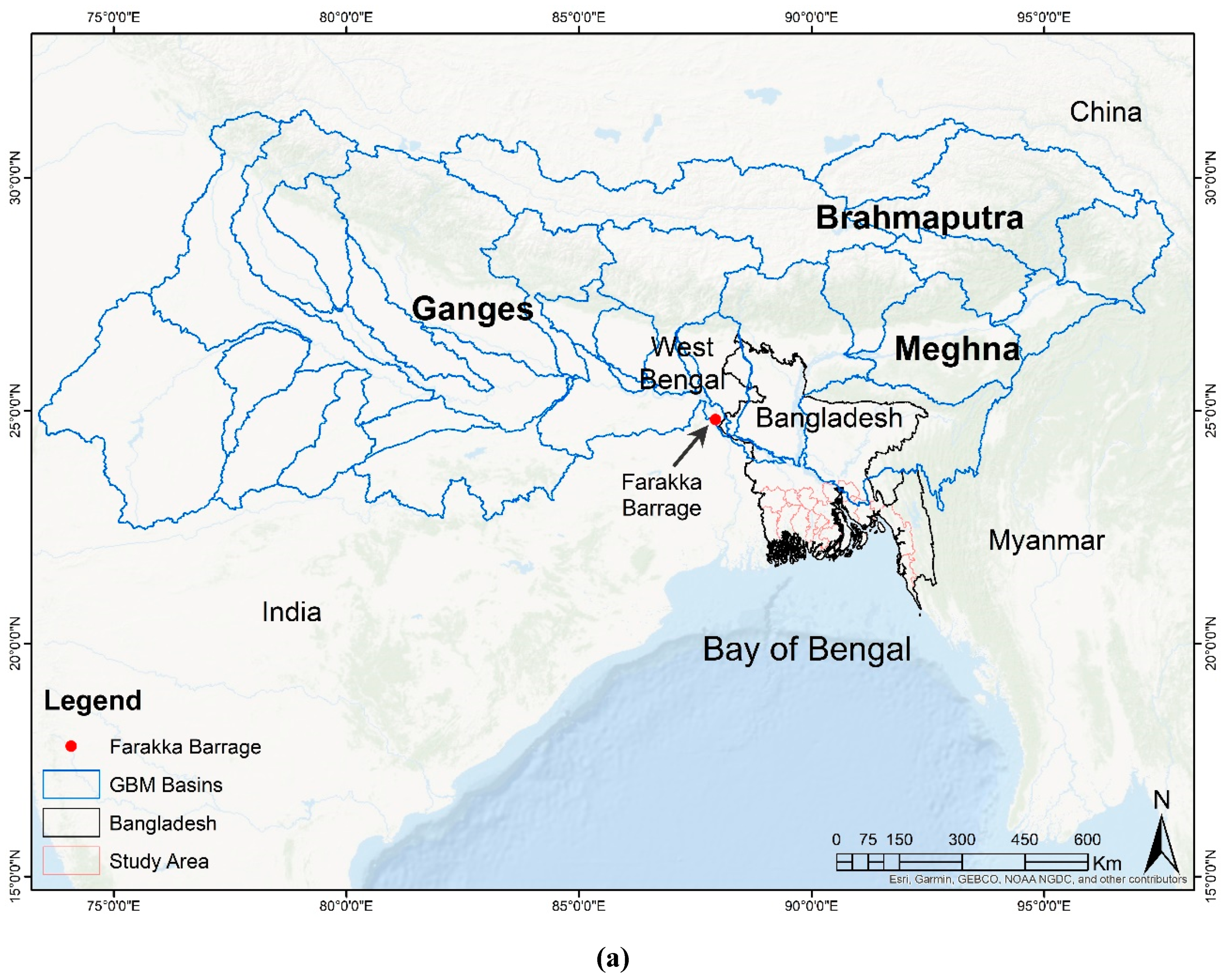
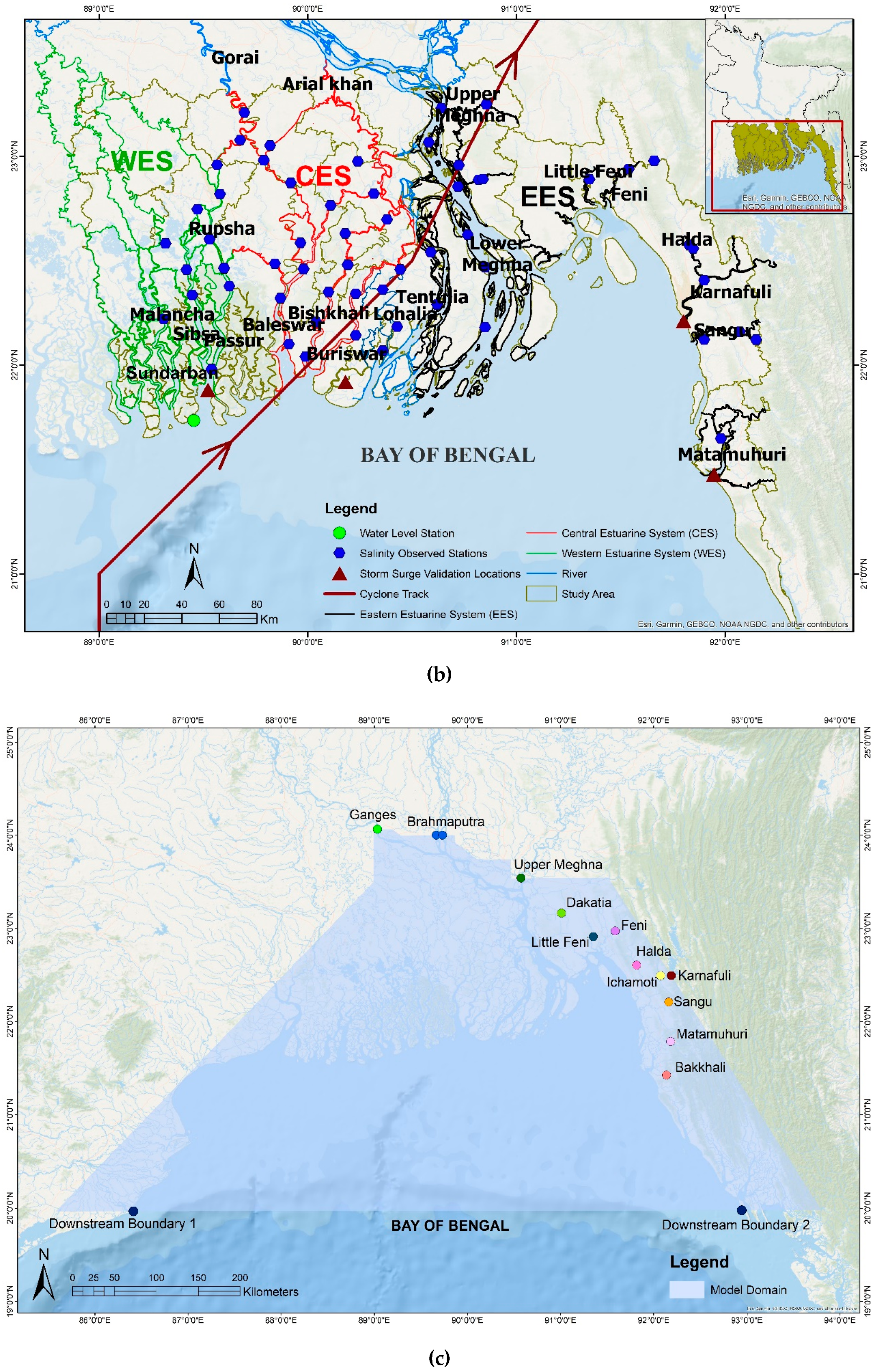
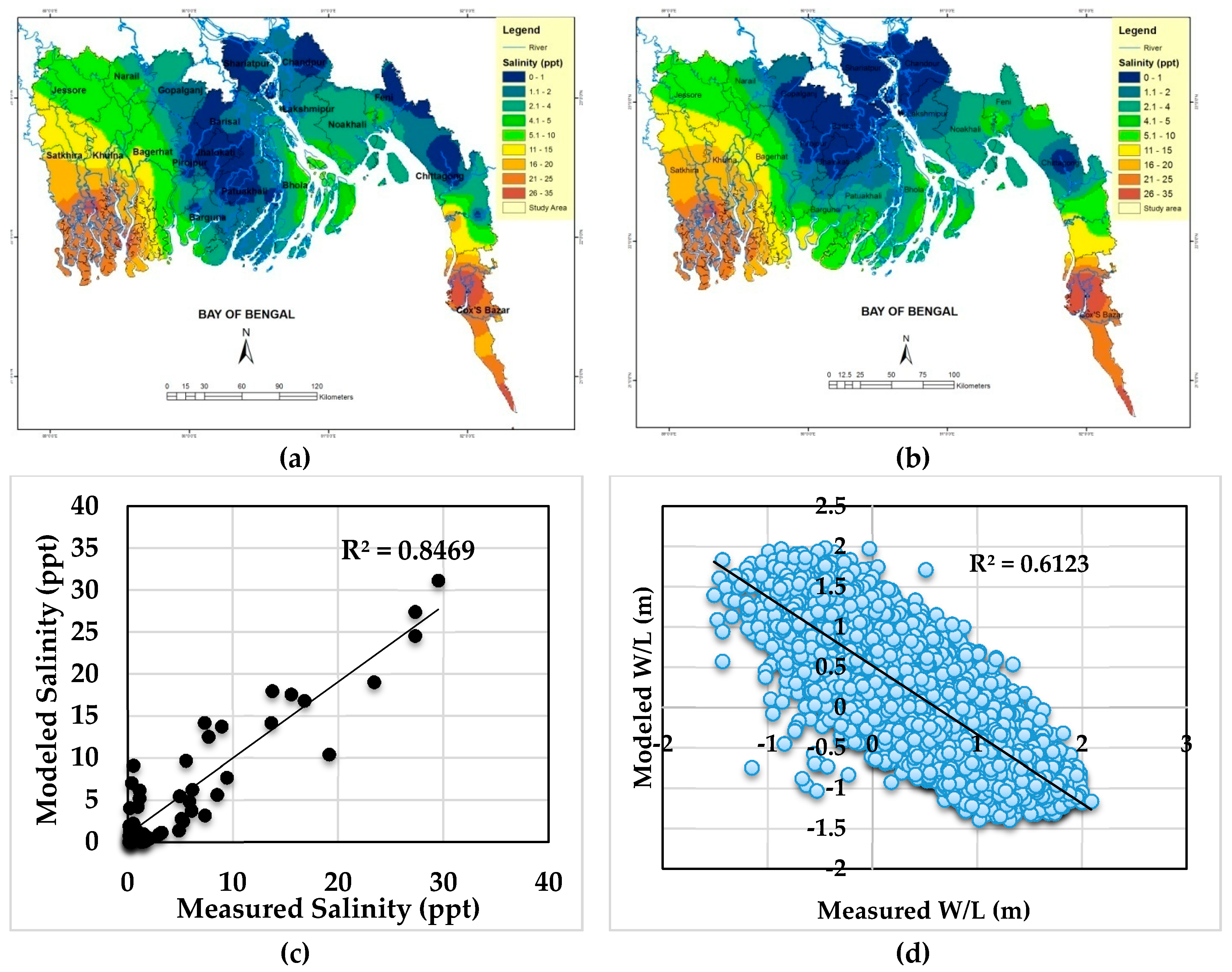
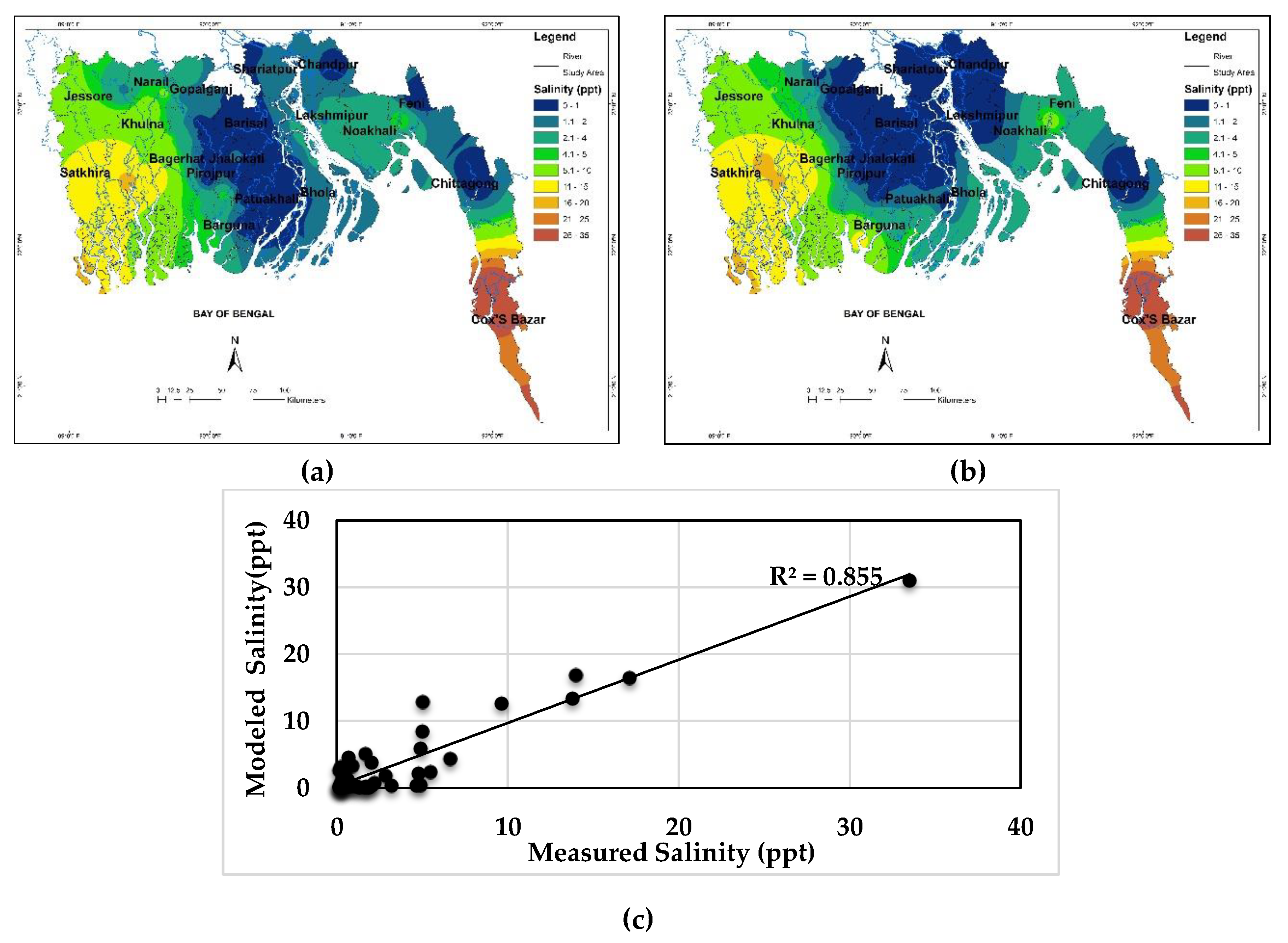
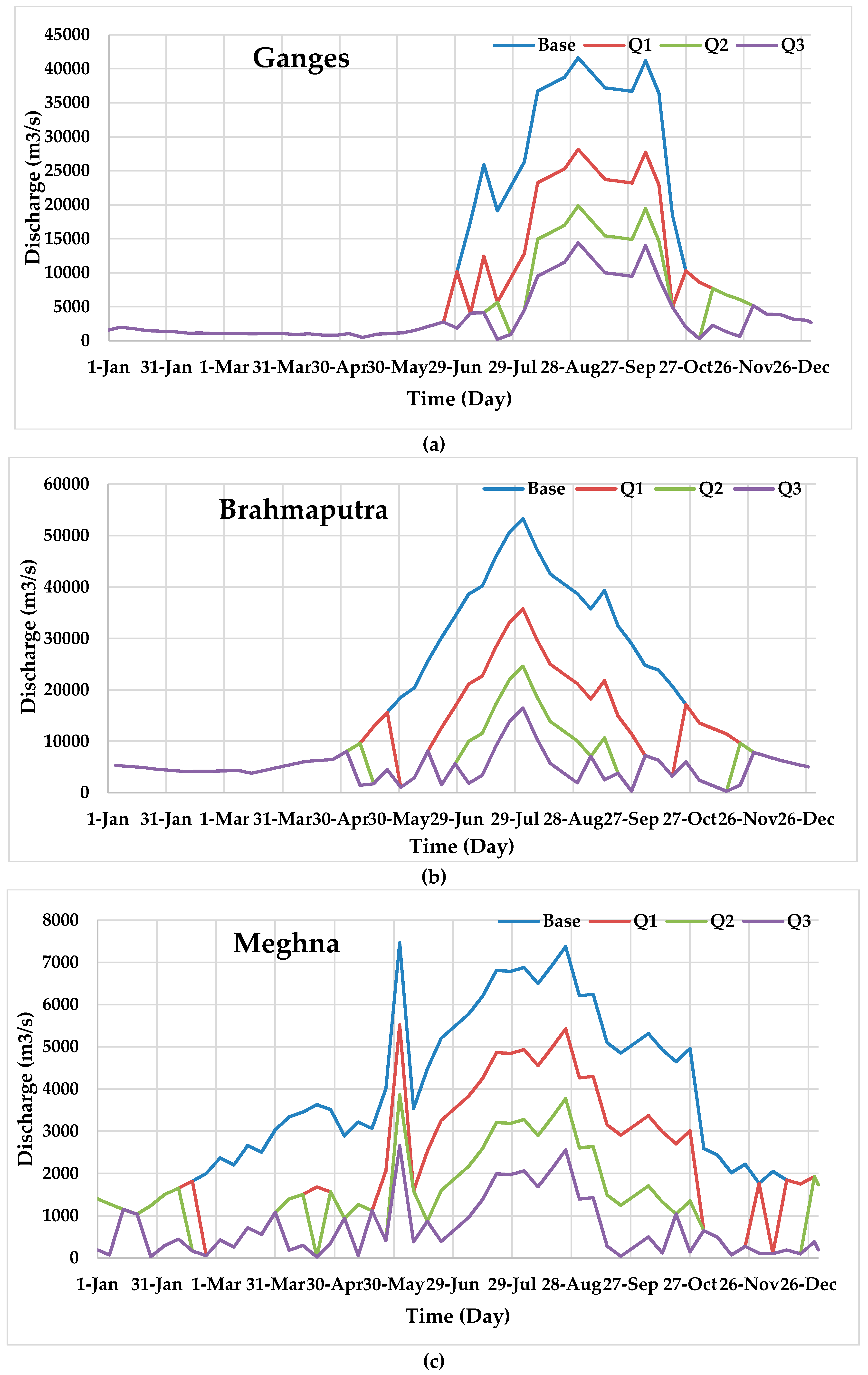
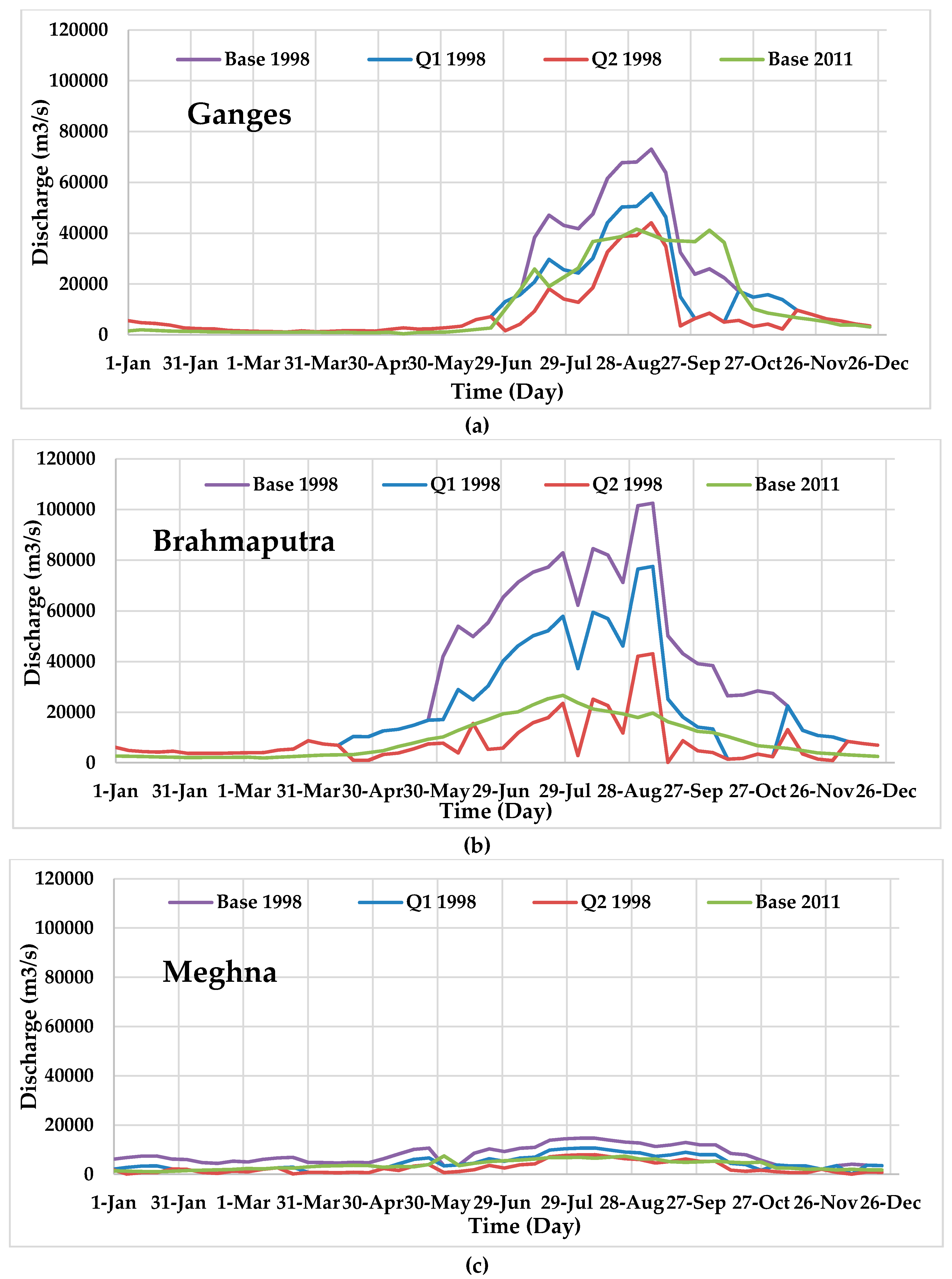

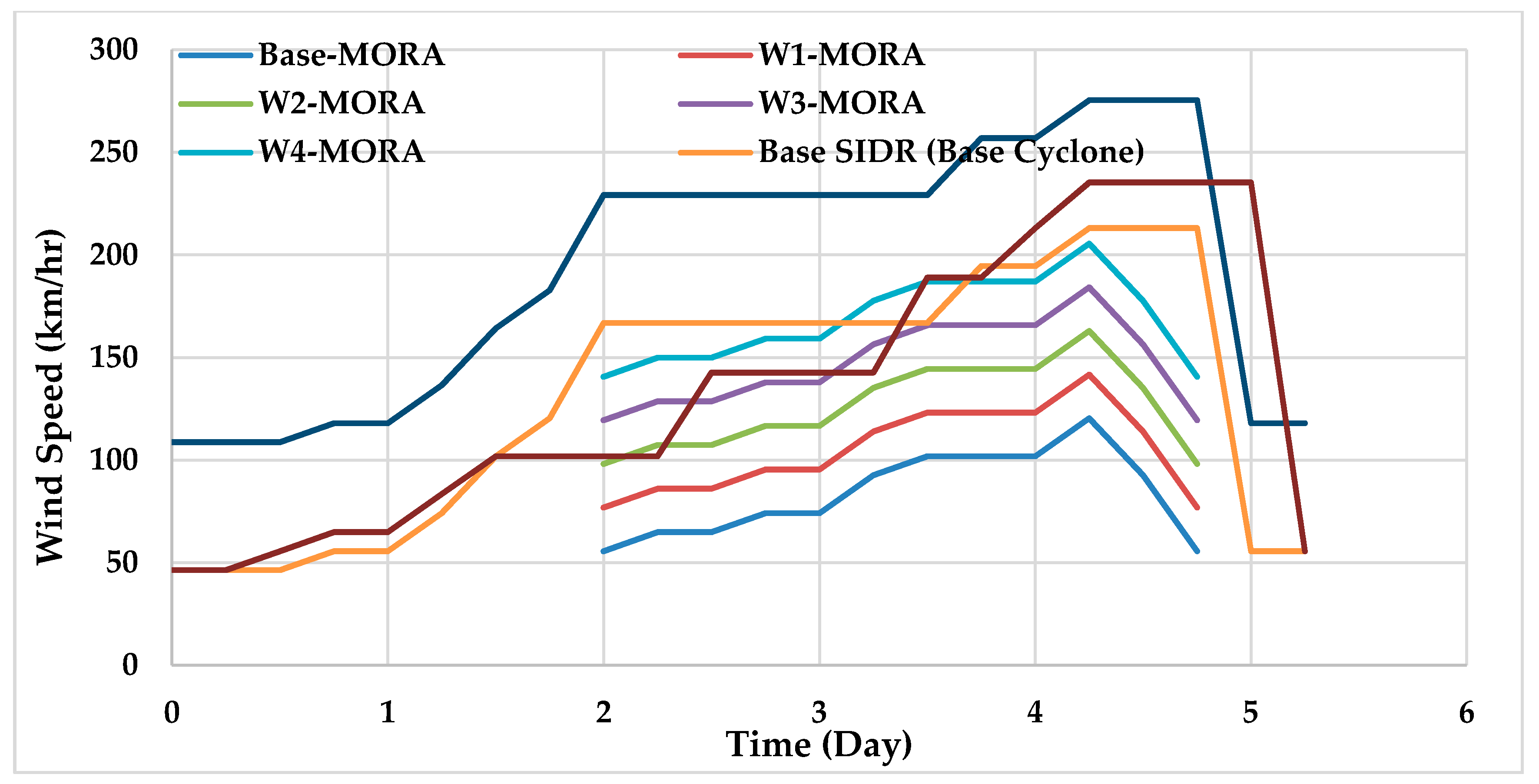
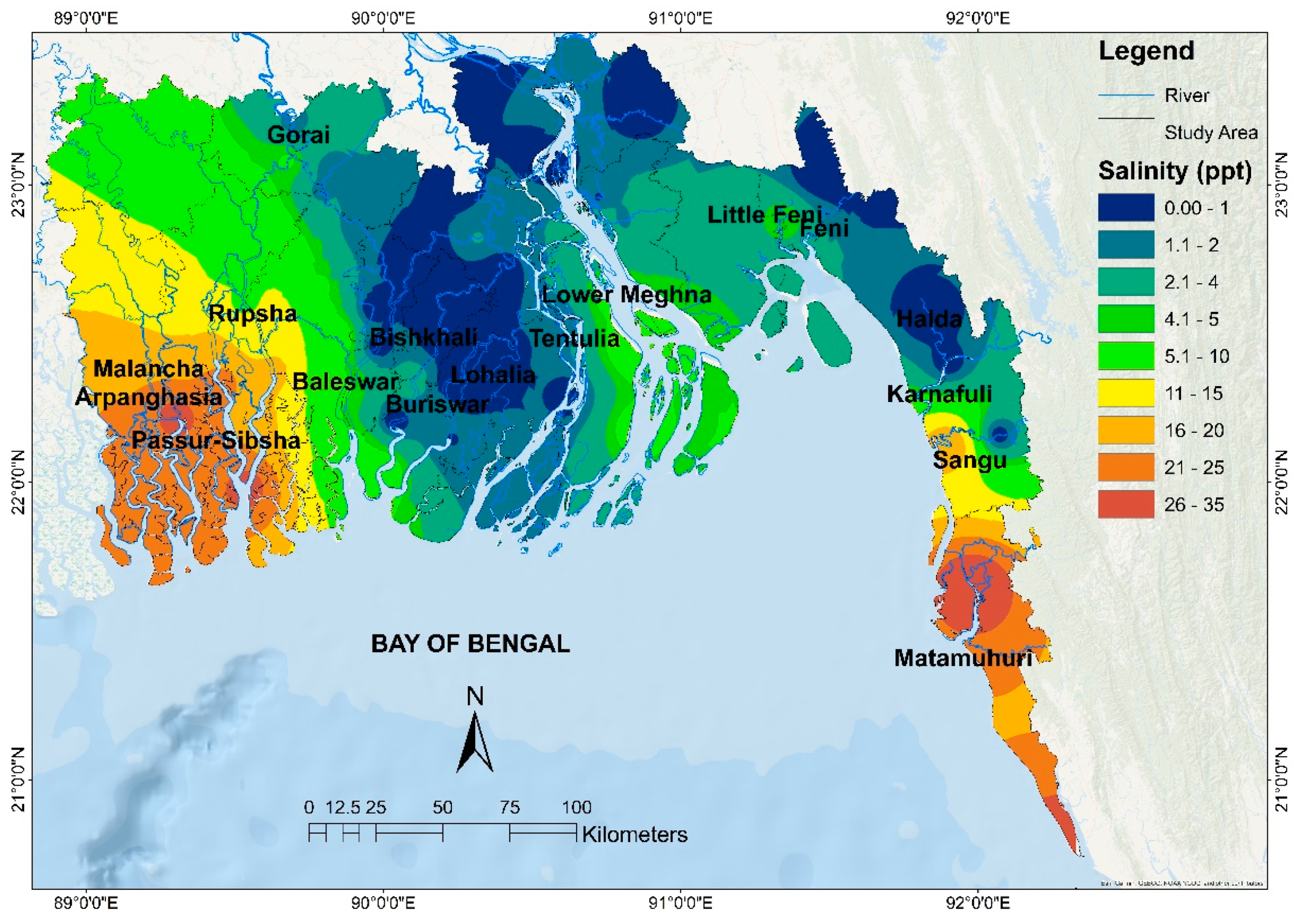
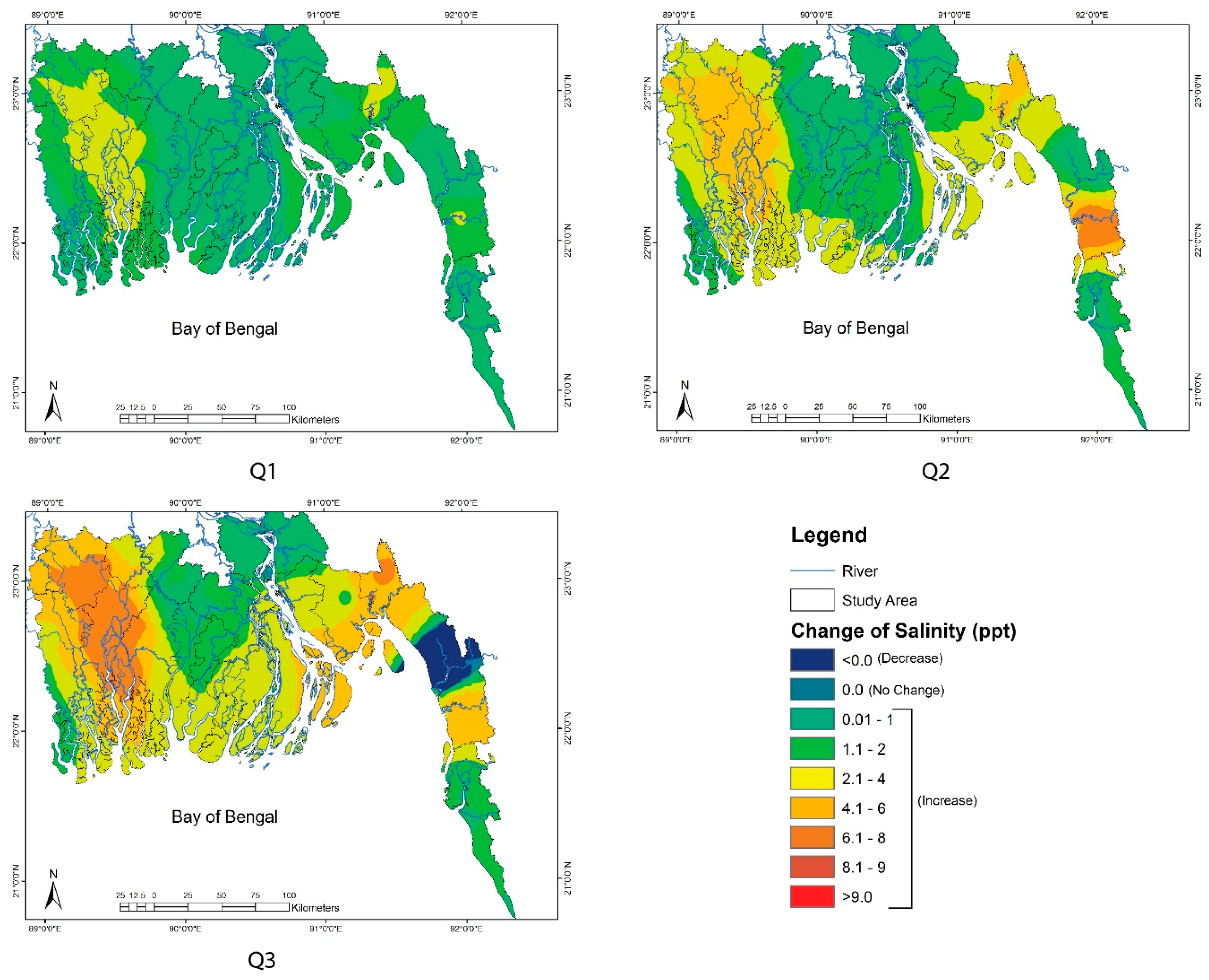
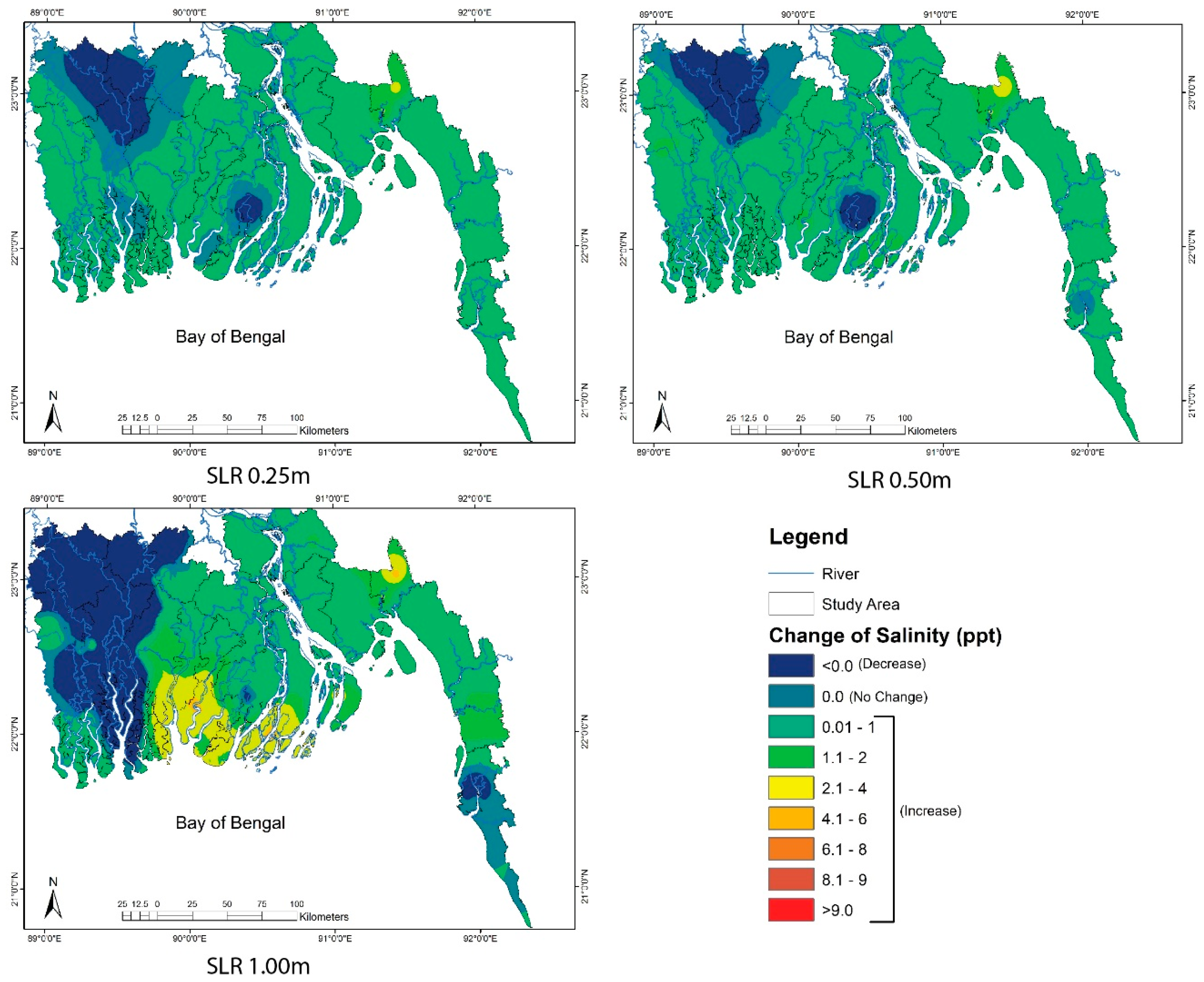
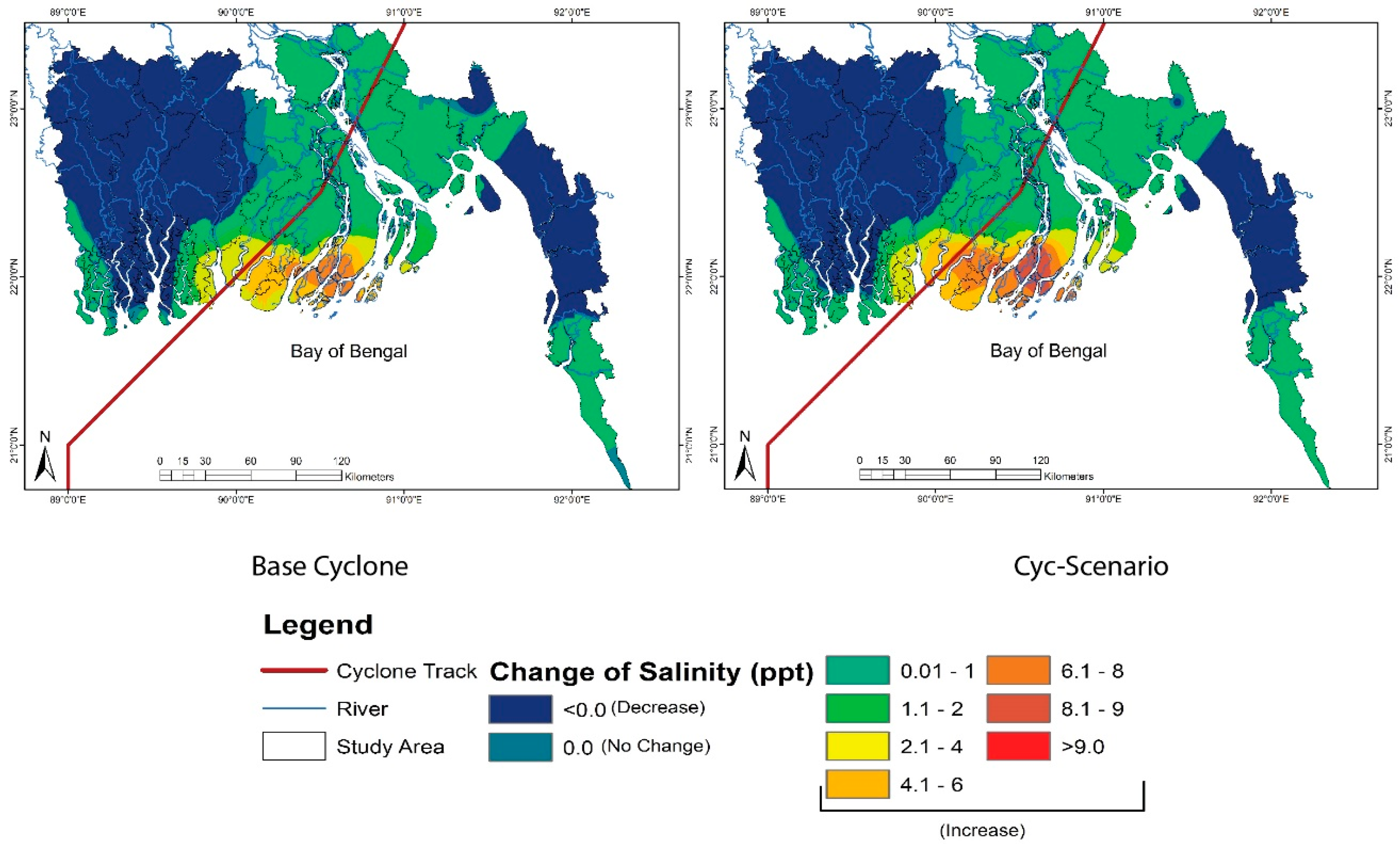
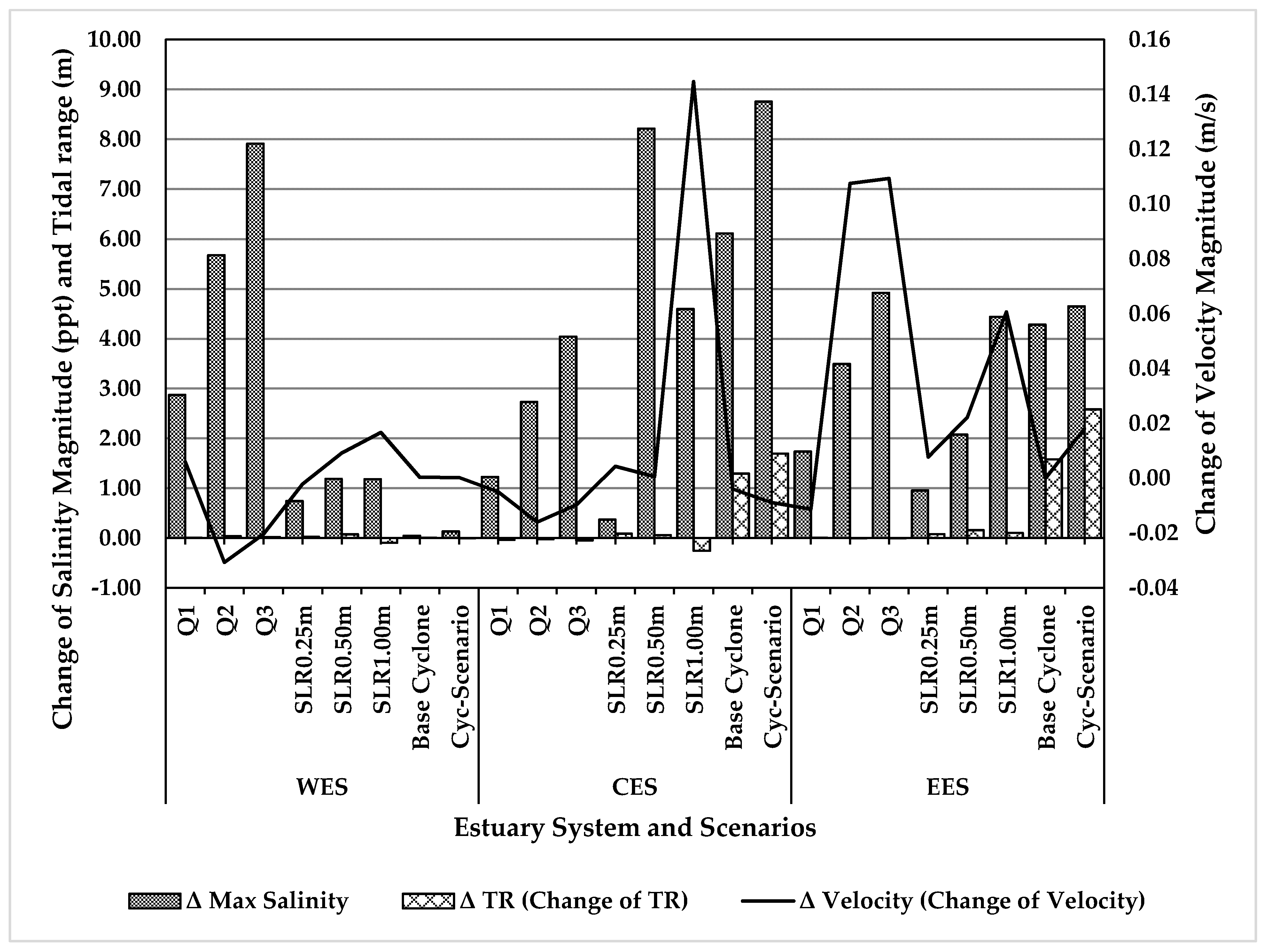
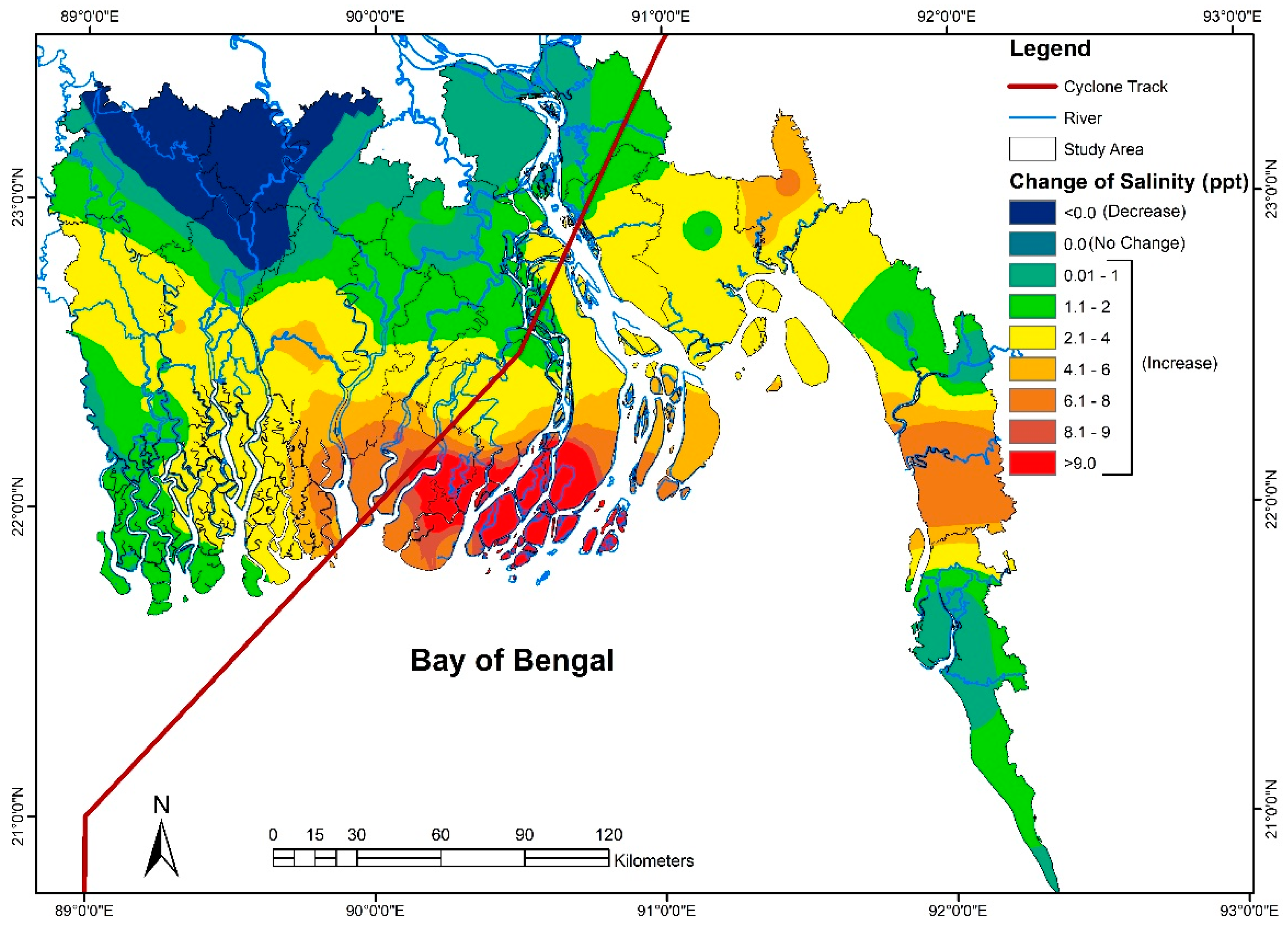
| Parameter | WES | CES | EES |
|---|---|---|---|
| Roughness | 0.62 | 0.56 | 0.75 * |
| Eddy diffusivity (m2/s) | 0.53 | 0.83 * | 0.35 |
| Velocity (m/s) | 0.82 * | 0.65 | 0.62 |
| Water Level (m) | 0.69 | 0.66 | 0.74 |
 Acceptable Acceptable  Not Acceptable Not Acceptable | ||||||||||
|---|---|---|---|---|---|---|---|---|---|---|
| Estuary System | WES | CES | EES | Entire System | Acceptable Range | |||||
| Statistical Indicators | Calibration | Validation | Calibration | Validation | Calibration | Validation | Calibration | Validation | ||
| Mean (ppt) | Δ (Observed-Model) | −0.61 | 1.15 | −0.42 | −0.63 | 0.28 | 0.09 | −0.17 | −0.07 | n/a ** <1.0 (assumed) |
| STDEV (ppt) | 1.06 | −1.13 | −0.97 | −0.42 | 0.31 | 0.09 | 0.04 | −0.13 | n/a ** <1.0 (assumed) | |
| MAE (ppt) | 2.40 | 2.00 | 1.85 | 1.67 | 1.64 | 1.64 | 1.88 | 1.70 | n/a ** <2.0ppt *** (assumed) | |
| RMSE (ppt) | 3.00 | 2.50 | 2.50 | 2.46 | 2.45 | 2.03 | 2.59 | 2.30 | <3.8 * | |
| PBIAS (%) | −4.00 | 21.54 | −20.80 | −27.95 | 6.71 | 2.29 | −3.18 | −2.13 | ±25 *% | |
| NSE | 0.83 | 0.70 | −0.13 | 0.58 | 0.88 | 0.93 | 0.92 | 0.88 | >0.5 * | |
| RSR | 0.41 | 0.55 | 1.03 | 0.65 | 0.35 | 0.27 | 0.28 | 0.34 | ≤0.7 * | |
| R2 | 0.84 | 0.86 | 0.44 | 0.68 | 0.87 | 0.93 | 0.89 | 0.86 | >0.5 * | |
| Number (8) | 6 | 5 | 5 | 7 | 8 | 8 | 8 | 8 | ||
| Final evaluation | ||||||||||
| (√ or ×)**** | √ | √ | √ | √ | √ | √ | √ | √ | ||
| Climate Condition | Scenario Name | Scenario Description | ||||||
|---|---|---|---|---|---|---|---|---|
| Upstream Boundary Condition Name | Yearly | Upstream Boundary Condition | Downstream Boundary Condition | Cyclonic Condition | ||||
| Maximum (m3/s) | Minimum (m3/s) | Average (m3/s) | ||||||
| Base Condition | Base | G * | 41611 | 457 | 11733 | Measured discharge-2011 [68] | NAO-tide [51] | No cyclone |
| B ** | 53317 | 3797 | 18424 | |||||
| M *** | 7468 | 1035 | 3777 | |||||
| Reduced discharge | Q1 | G * | 28134 | 457 | 7587 | Measured discharge-2011 [68] minus Standard deviation of Base | NAO-tide [51] | No cyclone |
| B ** | 35779 | 1025 | 11341 | |||||
| M *** | 5521 | 53 | 2242 | |||||
| Q2 | G * | 19836 | 285 | 5033 | Q1 minus Standard deviation of Q1 | NAO-tide [51] | No cyclone | |
| B ** | 24639 | 285 | 6843 | |||||
| M *** | 3863 | 23 | 1381 | |||||
| Q3 | G * | 14405 | 190 | 3571 | Q2 minus Standard deviation of Q2 | NAO-tide [51] | No cyclone | |
| B ** | 16475 | 285 | 4959 | |||||
| M *** | 2653 | 23 | 706 | |||||
| Sea Level Rise | SLR 0.25 m | Measured discharge-2011 [68] | NAO-tide [51] plus 0.25m | No cyclone | ||||
| SLR 0.50 m | Measured discharge-2011 [68] | NAO-tide [51] plus 0.50m | No cyclone | |||||
| SLR 1.0 m | Measured discharge-2011 [68] | NAO-tide [51] plus 1.00m | No cyclone | |||||
| Cyclonic | Base Cyclone | Measured discharge-2011 [68] | NAO-tide [51] | TC SIDR | ||||
| Cyc-Scenario | Measured discharge-2011 [68] | NAO-tide [51] | TC SIDR plus Standard deviation of wind speed of TC SIDR | |||||
© 2019 by the authors. Licensee MDPI, Basel, Switzerland. This article is an open access article distributed under the terms and conditions of the Creative Commons Attribution (CC BY) license (http://creativecommons.org/licenses/by/4.0/).
Share and Cite
Akter, R.; Asik, T.Z.; Sakib, M.; Akter, M.; Sakib, M.N.; Al Azad, A.S.M.A.; Maruf, M.; Haque, A.; Rahman, M.M. The Dominant Climate Change Event for Salinity Intrusion in the GBM Delta. Climate 2019, 7, 69. https://doi.org/10.3390/cli7050069
Akter R, Asik TZ, Sakib M, Akter M, Sakib MN, Al Azad ASMA, Maruf M, Haque A, Rahman MM. The Dominant Climate Change Event for Salinity Intrusion in the GBM Delta. Climate. 2019; 7(5):69. https://doi.org/10.3390/cli7050069
Chicago/Turabian StyleAkter, Rabeya, Tansir Zaman Asik, Mohiuddin Sakib, Marin Akter, Mostofa Najmus Sakib, A. S. M. Alauddin Al Azad, Montasir Maruf, Anisul Haque, and Md. Munsur Rahman. 2019. "The Dominant Climate Change Event for Salinity Intrusion in the GBM Delta" Climate 7, no. 5: 69. https://doi.org/10.3390/cli7050069
APA StyleAkter, R., Asik, T. Z., Sakib, M., Akter, M., Sakib, M. N., Al Azad, A. S. M. A., Maruf, M., Haque, A., & Rahman, M. M. (2019). The Dominant Climate Change Event for Salinity Intrusion in the GBM Delta. Climate, 7(5), 69. https://doi.org/10.3390/cli7050069





